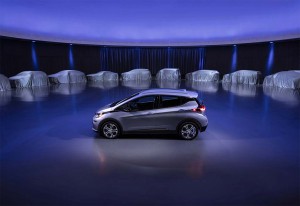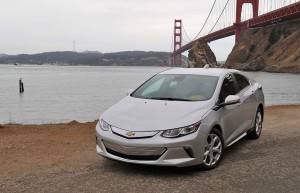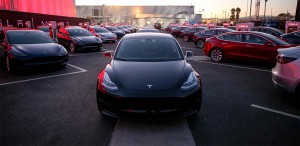Despite a slow start for its Chevrolet Bolt EV, General Motors “believes in an all-electric future,” the maker’s global product development chief said Monday, announcing GM will back that up with the launch of 20 pure battery-electric vehicles, or BEVs, by 2023.
The Bolt, the automaker’s first long-range electric model, will be joined by two other BEVs within the next 18 months, GM also confirmed Monday. The largest of Detroit’s Big Three automakers also revealed a fuel-cell-powered heavy-duty truck concept dubbed SURUS, that could be used for a variety of purposes, such as a delivery vehicle or first-responder vehicle.
GM joins a growing list of manufacturers who have, in recent months, announced plans to greatly expand their range of battery and fuel-cell vehicles. Some, such as Volvo, intend to only offer electrified drivelines, others, such as Volkswagen, say they will have electrified options available on all future models. But while it has not set out a timeline, GM intends to go to 100% pure electric across the board, officials said.
(Toyota, Mazda, Denso joining forces to build new line of electric vehicles. Click Here for the story.)
“General Motors believes in an all-electric future,” said Mark Reuss, the executive vice president who oversees purchasing and supply chain operations, as well as product development. “Although that future won’t happen overnight, GM is committed to driving increased usage and acceptance of electric vehicles through no-compromise solutions that meet our customers’ needs.”
In comments released by GM on its media site Monday, Reuss did not clarify whether the move planned by GM will include conventional hybrids and plug-in hybrids or will see GM shift completely to BEV models and hydrogen-powered vehicles exclusively.
Currently, GM offers a number of conventional hybrids, as well as the plug-in hybrid Chevrolet Volt. That model originally debuted in 2010 and was redesigned in 2016. The current version can get more than 50 miles on battery power alone before firing up its internal combustion engine for longer journeys.
GM introduced its first long-range EV, the Chevy Bolt, in December 2015. It is rated at 238 miles per charge. The vehicle, which competes against the new Tesla Model 3, was named North American Car of the Year by a jury of 60 U.S. and Canadian journalists in January of this year.
The push to electrify has been a long time in coming. California regulators first launched a zero-emissions mandate two decades ago but rolled it back when it became clear the technology of that era would not meet consumer demand.
Newer lithium-ion batteries have drastically improved the capabilities of electrified vehicles and there are now dozens of hybrids, plug-ins and BEVs on the market, as well as three hydrogen fuel-cell vehicles. Hundreds more are expected by early in the coming decade.
Government mandates, including the latest version of the California ZEV rules, are leading to a rapid adoption of alternative powertrain technologies – even though President Donald Trump’s EPA is expected to roll back the strict U.S. fuel economy rules set to phase in through 2025. And pressures are growing even tighter overseas. Several countries, including Norway and India, now plan to ban internal combustion engines entirely. The UK, France, Germany and China are considering similar moves.
China has just laid out new guidelines for alternative propulsion and is now the world’s biggest market for electrified vehicles.
(Nissan set to add new electric SUV. Click Here for the latest.)
GM is intentionally being vague about its plans for switching to an all-electric powertrain strategy, but it is clearly planning to amp up its offerings in the relative near-term. That will start with the addition of two new BEVs over the next 18 months which “will be the first of at least 20 new all-electric vehicles that will launch by 2023,” the company said in a statement.
While those products are expected to use batteries to provide power, GM is also development SURUS, short for Silent Utility Rover Universal Superstructure, which it calls a “fuel-cell-powered, four-wheel steer concept vehicle on a heavy-duty truck frame that’s driven by two electric motors.”
GM has been a pioneer in the development of fuel-cell technology, putting its first prototype on the road four decades ago. It early this year launched a joint venture with Honda to begin producing fuel-cell stacks that could be used in vehicles as well as stationary power systems. Honda is expected to use the new hardware in the next version of its Clarity Fuel-Cell Vehicle. GM has not yet indicated what it intends to use the stacks for, but SURUS offers a hint.
The Detroit maker has also been developing concept fuel-cell trucks that could be used by the U.S. military, as well as a drone-like mini-submarine that the Navy could use for extended underwater research projects.
(Toyota set to reveal electrification strategy at 2018 Detroit Auto Show. For the story, Click Here.)




The LS- and LT1-series may have some things to say about an “all electric” future…
I have been driving some high-performance electric models and you may be surprised…
Does GM need another bankruptcy before they remember that profits come before the sandbox?
Do note that they have offered no actual timetable for the switch to all-electric. They’re moving no faster than any key competitor, in fact, through at least 2023.
Paul E.